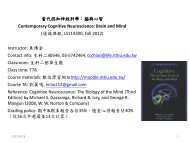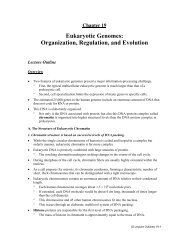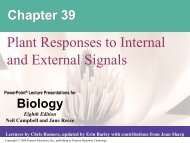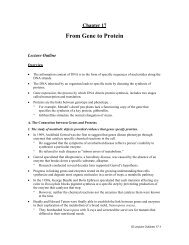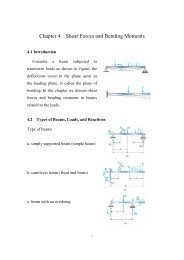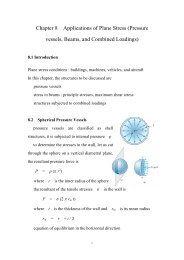- HH0014 - Bose-Einstein Condensation
- HH0014 - Bose-Einstein Condensation
- HH0014 - Bose-Einstein Condensation
Create successful ePaper yourself
Turn your PDF publications into a flip-book with our unique Google optimized e-Paper software.
- <strong>HH0014</strong> -<strong>Bose</strong>-<strong>Einstein</strong> <strong>Condensation</strong>Hsiu-Hau Linhsiuhau.lin@gmail.com(Dec 23, 2011)Consider a system composed of non-interaction bosons inside a box ofvolume V = L 3 . It is convenient to introduce the temperature-dependentquantum concentration,( mτ) 3/2n Q (τ) = . (1)2π 2In previous lectures, we understand that quantum statistics starts to playimportant role when crossing the boundary n ≈ n Q (τ). Unlike the smoothcrossover for non-interacting fermions from the classical regime to the quantumterritory, there is a true phase transition for bosons to cross the boundaryfrom the classical to the quantum. As will be elaborated later, the transitionoccurs atnn Q= ζ(3/2) ≈ 2.612 (2)For small density n or high temperature τ, the boson system is in the classicalregime. On the other hand, by either lowering the temperature or increasingthe density, it enters the condensed phase, often referred as <strong>Bose</strong>-<strong>Einstein</strong>condensate.The existence of condensate is defined by the notion of “macroscopicoccupation”. For each orbital, one can define its macroscopic occupation,f(ɛ s )n(ɛ s ) ≡ limV →∞ V1= limV →∞ V1exp[(ɛ s − µ)/τ] − 1 . (3)Except the lowest orbital, ɛ s − µ > 0, ensuring the <strong>Bose</strong> function is alwaysfinite. In consequence, the corresponding macroscopic occupation is zero inthe thermodynamic limit (V → ∞). For the lowest orbital, it is possiblethat ɛ s − µ is tiny and goes to zero as V → ∞. The singularity in the <strong>Bose</strong>function may cancel the 1/V factor and gives rise to non-zero macroscopicoccupation. In general, phase transition occurs when singularity develops inthermodynamic limit, i.e. V → ∞ and is usually very difficult to describein complete details. The <strong>Bose</strong>-<strong>Einstein</strong> condensation is one of the few exampleswhere how the singularity arises can be understood without too muchmathematical difficulty.
-<strong>HH0014</strong>- <strong>Bose</strong>-<strong>Einstein</strong> condensation 2f Ε s 1.00.80.60.40.20 10 20 30 40 ΤΛΤ1.00.90.80.70 10 20 30 40 50 60 ΤFigure 1: A boson system with N s = 5 orbitals and N = 10 particles. Forsimplicity, the adjacent gap is set to unity, ∆ = 1.• finite-orbital boson systemLet us start with a simple boson system with N s = 5 orbitals and N =10 particles. For simplicity, let’s assume the orbital energies are ɛ s = s∆,with s = 0, 1, 2, 3, 4. The occupation fraction is defined as the ratio of theoccupation number and the total particle number,n s ≡ 1 N1(1/λ) e ɛs/τ − 1 , (4)where λ = e µ/τ is the absolute activity. The conservation of particles imposethe constraint on these occupation fractions,4∑n s = 1 Ns=04∑s=01(1/λ) e ɛs/τ − 1= 1. (5)The absolute activity can then by solved numerically as plotted in Figure1. At high temperatures, it is clear that n s ≈ 1/N s = 1/5. However, asthe temperature cools down, the occupation fraction for the lowest orbitaln 0 approaches unity, while all other occupation fractions falls down to zero.The absolute activities at low and high temperatures can be computed.In the low temperature regime, the occupation is dominated by the lowestorbital,N ≈1(1/λ 0 ) − 1→ λ 0 ≈ NN + 1≈ 0.91. (6)At high temperatures, all occupation fractions are the same and the energydifference can be ignored,N ≈ N s1(1/λ ∞ ) − 1→λ ∞ ≈NN + N s≈ 0.67. (7)
-<strong>HH0014</strong>- <strong>Bose</strong>-<strong>Einstein</strong> condensation 3The above results can be checked in Figure 1. Because both N s and N arefinite here, there is no singularity.However, for <strong>Bose</strong> gas in three dimensions, there are infinite states (N s →∞) and the absolute activity λ → 0 in the high temperature limit (τ → ∞).Meanwhile, it is expected that all occupation fractions vanish as 1/N s athigh temperatures. On the other hand, in the low-temperature regime, n 0will be of order one, much larger than other occupation fractions. The drasticdifferent trends in high and low temperatures imply some sort of singularity,emerging in the thermodynamic limit.• near zero temperatureThere are different ways to understand how <strong>Bose</strong>-<strong>Einstein</strong> condensation occurs.Let us follow Kittel’s textbook and start with the low temperaturelimit first. Suppose the total particle number N is large but not infinite.Near τ = 0, almost all bosons are in the ground state. The <strong>Bose</strong>-<strong>Einstein</strong>distribution simplifies,N = ∑ sOne can then solve for the absolute activity,11λ eɛs/τ − 1 ≈ λ1 − λ . (8)λ ≈NN + 1 ≈ 1 − 1 N(9)In the thermodynamic limit, λ = 1. It gives rise to singularity and leads tomacroscopic occupation in the lowest orbital. The chemical potential is(µ = τ log λ = −τ log 1 + 1 )≈ − τ N N . (10)The chemical potential is very close to zero but slightly less than zero. This isa very nice realization of the mathematical notion “0 − ” in a physical system.• almost-zero chemical potentialConsider an atom inside a cube of volume V = L 3 . The energy of the singleparticleorbital isɛ = 2 π 2 ( )n22mL 2 x + n 2 y + n 2 z . (11)
-<strong>HH0014</strong>- <strong>Bose</strong>-<strong>Einstein</strong> condensation 4The energies of the lowest and the second lowest orbitals areɛ 0 = 2 π 22mL (1 + 1 + 1), ɛ 2 1 = 2 π 2(4 + 1 + 1). (12)2mL2 Take m = 6.6 × 10 −27 Kg ( 4 He atom) and L = 1 m, it is straightforward toestimate the energy gap between the lowest two orbitals.∆ɛ = ɛ 1 − ɛ 0 ≈ k B × 10 −18 K. (13)The energy gap is tiny for a macroscopic system. It is hard to imagine howsuch a tiny energy difference can play any significant role in a physical system.Well, it does and here comes the surprise!For a <strong>Bose</strong> gas of N = 10 23 atoms at 1 mK, the chemical potential isµ ≈ ɛ 0 − τ N = ɛ 0 − k B × 10 −26 K, (14)where ɛ 0 is the energy of the lowest orbital. The occupation number of thesecond lowest orbital is approximatelyf(ɛ 1 ) =1exp[(ɛ 1 − µ)/τ] − 1 ≈ 1exp(∆ɛ/τ) − 1 ≈ τ ∆ɛ = 1015 . (15)The number may look large at first glance but the corresponding fraction isactually very small,f(ɛ 1 )N ≈ τN∆ɛ ≈ (ɛ 0 − µ)ɛ 1 − ɛ 0≈ 10 −8 (16)That is to say, the chemical potential is much closer to the energy of thelowest orbital than the tiny energy gap ∆ɛ. For a <strong>Bose</strong> gas with constantdensity n, the energy gap ∆ɛ ∼ 1/V 2/3 in the thermodynamic limit. But,ɛ 0 −µ ∼ 1/N ∼ 1/V goes to zero faster. As a result, the occupation fraction ofthe second lowest orbital approaches zero even though its energy is extremelyclose to that of the lowest orbital.• cooling down from high temperatureNow we reverse the direction and try to understand the <strong>Bose</strong> gas from thehigh temperature side. The total number is expressed as the sum of <strong>Bose</strong>functions over all orbitals,N = ∑ s11λ eɛs/τ − 1 . (17)
-<strong>HH0014</strong>- <strong>Bose</strong>-<strong>Einstein</strong> condensation 6n Q is large and the inequality is easily satisfied. But, as the temperature coolsdown to the critical one,( mτc) 3/2 ( mτc) 3/2n = g 3 (1) ≈ 2.612 , (23)2 2π 2 2π 2The absolute activity reaches unity, λ = 1, i.e. µ = 0. This is already strangebecause the occupation number of the lowest orbital becomes singular. Whatif we further cool down the <strong>Bose</strong> gas below the critical temperature τ c ? Troubled...We don’t even have a real solution for λ if the temperature is cooledbelow the critical one!• macroscopic occupation of the lowest orbitalThe confusions stem from the macroscopic occupation of the lowest orbital,n 0 = 1 Vλ1 − λ . (24)Since the density of state at ɛ = 0 vanishes, it is legal to separate the occupationnumber of the lowest orbital and the others. If the volume is large(but not yet infinite), the summation can again be converted into integraland the density can be expressed asn = n 0 + n Q g 3 (λ). (25)2Note that, if we blindly take the thermodynamic limit (V → ∞),1n 0 = limV →∞ Vλ1 − λ= 0. (26)We then come back to the same expression in previous paragraphs. To overcomethe difficulty explained before, one needs to be cautious when takingthe thermodynamic limit. For τ > τ c , the absolute activity can be solvedfrom n = g 3 (λ). For τ < τ c , one should keep the volume large but finite2momentarily. As can be seen in Figure 2, the equation n = n 0 + n Q g 3 (λ)2indeed has a real solution for λ,λ ≈ 1 − 1 N( nn 0), when n 0 ≠ 0. (27)It is worth emphasizing that the above relation is true only when n 0 ≠ 0and the particle number N is enormous. When the macroscopic occupation
-<strong>HH0014</strong>- <strong>Bose</strong>-<strong>Einstein</strong> condensation 7is nonzero, a finite fraction of particles stay in the lowest orbital, referred as<strong>Bose</strong>-<strong>Einstein</strong> condensate. Though we only work out the critical temperaturehere, it is expected that all other physical quantities in the condensate canbe computed with more advanced techniques.Meanwhile, the temperature dependence of the condensation fraction canbe derived,( ) ]3n 0 = n − n Q g 3 τ22 (1) = n[1 − . (28)τ cBecause N for a macroscopic system is huge (of the order 10 23 ), even for τslightly less than the critical temperature τ c , a large number of bosons occupythe lowest orbital. These particles in the lowest orbital form a condensateand usually give rise to superfluidity when realistic interactions are included.• phase transition due to singularityThe emergence of a condensate marks a true phase transition from the gasphase to the condensation phase. The phase transition is associated with thenonuniform convergence so that the order of limits does not commute,lim limλ→1 V →∞lim limV →∞ λ→11V1Vλ1 − λ = 0 (29)λ1 − λ = ∞ (30)If the thermodynamic limit is taken first, the macroscopic occupation is alwayszero. However, if the absolute activity is taken to be unity first, themacroscopic occupation is divergent. None of the results are sensible andthese two limits are not independent but related: 1 − λ ≈ 1/(n 0 V ). A finalcomment is that the pause transition is not directly related to τ → 0 limit –the condensation occurs at finite temperature!• occupation number fluctuationsIt is interesting to study the fluctuation of the occupation number in a <strong>Bose</strong>gas. The occupation number for each orbital is〈N s 〉 = 1 Z∞∑m e −m(ɛs−µ)/τ , (31)m=0
-<strong>HH0014</strong>- <strong>Bose</strong>-<strong>Einstein</strong> condensation 8where Z is the Gibbs sum. Taking derivative with respect to ɛ s , one finds auseful identity,−τ ∂∂ɛ s〈N s 〉 = 1 Z∞∑m=0m 2 e −mɛs/τ + τ Z 2 ∂Z∂ɛ s∞∑m=0m e −mɛs/τ . (32)After a little bit of massage, the above identity can be rewritten as〈N 2 s 〉 − 〈N s 〉 2 = −τ ∂∂ɛ s〈N s 〉. (33)Since the occupation number is 〈N s 〉 = [e (ɛs−µ)/τ − 1] −1 , it is straightforwardto obtain the fluctuations in particle numbers,(∆N s ) 2 ≡ 〈N 2 s 〉 − 〈N s 〉 2 =e (ɛs−µ)/τ[e (ɛs−µ)/τ − 1] 2 = 〈N s〉 + 〈N s 〉 2 (34)For a <strong>Bose</strong> gas, the fluctuation is always strong, ∆N s /〈N s 〉 > 100%. It isimportant to stress that the fluctuation we discuss here is about the occupationnumber for each orbital, not the total particle number. It is quiteinteresting that the fluctuation is smaller when 〈N s 〉 is larger. As a result,in the condensation phase, the occupation fluctuation of the lowest orbital isthe smallest, ∆N 0 /〈N 0 〉 = 1 while other orbitals gave stronger fluctuations.The strong fluctuation in the occupation number reflects the nature of noninteractingbosons: they love to hang out together, known as boson bunchingeffects in the literature.



